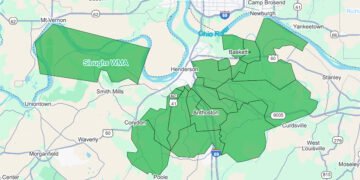Rock Bluff Energy officials say they plan on approximately ’50-70 wind turbines’
A wind turbine proposal submitted to the Federal Aviation Administration so that it can conduct a study includes 93 possible locations where wind turbines could be built in eastern Henderson County.
The plan was submitted by Cordelio Power, which has been working locally with Rock Bluff Energy Park for a couple years gathering wind data and securing leases with landowners.
The proposal was submitted so that the FAA could conduct an aeronautical study and “to solicit aeronautical comments from the public concerning the physical effect of this proposal on the safe and efficient use of airspace by aircraft,” according to the public notice as a part of the aeronautical study, which has the number 2025-WTE-1934-OE.
It’s the first public look at the company’s wind energy plans in Henderson County. Rock Bluff Energy, however, said the 93 wind turbines mentioned are greater than what is planned to be built. In a statement to the Hendersonian, Rock Bluff said that number is “approximately 50-70 wind turbines.”
“The proposed locations in the application do not reflect final turbine locations,” said the statement. “Rather, they were placed across the project footprint to allow any potential obstructions to be identified. This allows the project’s engineering team to avoid any hazards when designing the final project plan.”
Additionally, the public notice says that the height of the turbines is 720 feet. Both local officials and those with Rock Bluff said 720 feet represents the maximum height of the wind turbine blades.
On the FAA’s Obstruction Evaluation/Airport Airspace Analysis page, a map showing the GIS locations of the 93 wind turbines is available.
Thus far, most of the work regarding the Rock Bluff Energy Park has not been in the public realm, but officials have said that wind turbines—and solar panels, which Rock Bluff had also been pursuing—would be placed on reclaimed Penn-Virginia mine land.
The map shows that many of the locations of the wind turbines are located outside the boundary of Penn-Virginia land. In the statement Rock Bluff said the locations of the wind turbines “will not be determined for over a year.”
The Henderson County Fiscal Court put in place a 2-year solar energy moratorium in February. But there were no restrictions put in place for work or research involving wind energy.
Henderson County Judge-Executive Brad Schneider, along with other local officials, said it will be years before wind turbines come to the county.
In addition to the federal regulations that must be met, Rock Bluff’s plans would need to follow regulations imposed by a county zoning ordinance regarding wind energy. Currently, the county does not have this zoning ordinance. Schneider said county officials have recently started the conversation about creating it.
The public comments associated with the FAA’s aeronautical study closed Friday. An official with the FAA in Atlanta said public comments would be available when the study is complete, which could be weeks.
A wind energy zoning ordinance would originate from Fiscal Court, which would then send it to the Henderson-Henderson County Planning Commission for its recommendations followed by its being sent back to the Fiscal Court for first and second readings.
Schneider said he’d like to have a zoning ordinance in place by the end of the year.
Below read the full statement from the Rock Bluff Energy Team:
“The Federal Aviation Administration (FAA) regulates all structures 200 feet above the ground or higher to ensure they are compatible with aviation safety and other uses of airspace like radar and military readiness.
This regulation applies to all utility-scale wind energy projects, including Rock Bluff. In February, the project filed an application with the FAA, including a map of 93 potential wind turbine locations. The proposed locations in the application do not reflect final turbine locations. Rather, they were placed across the project footprint to allow any potential obstructions to be identified. This allows the project’s engineering team to avoid any hazards when designing the final project plan. Rock Bluff still plans to install approximately 50-70 wind turbines; however, their locations will not be determined for over a year.
The agency is currently performing the Obstruction Evaluation/ Airport Airspace Analysis. The FAA manages this process and coordinates with other departments, including the Department of Defense (DOD), the Department of Homeland Security, and the National Oceanic and Atmospheric Administration, among others. Technicians within these agencies review each point to ensure that the proposed project does not interfere with their areas of responsibility.
During this inter-agency review, developers are notified of any potential concerns and work with the agencies to mitigate those issues. Filing an application with the FAA is the only way for projects to receive this expert-driven analysis.”






















